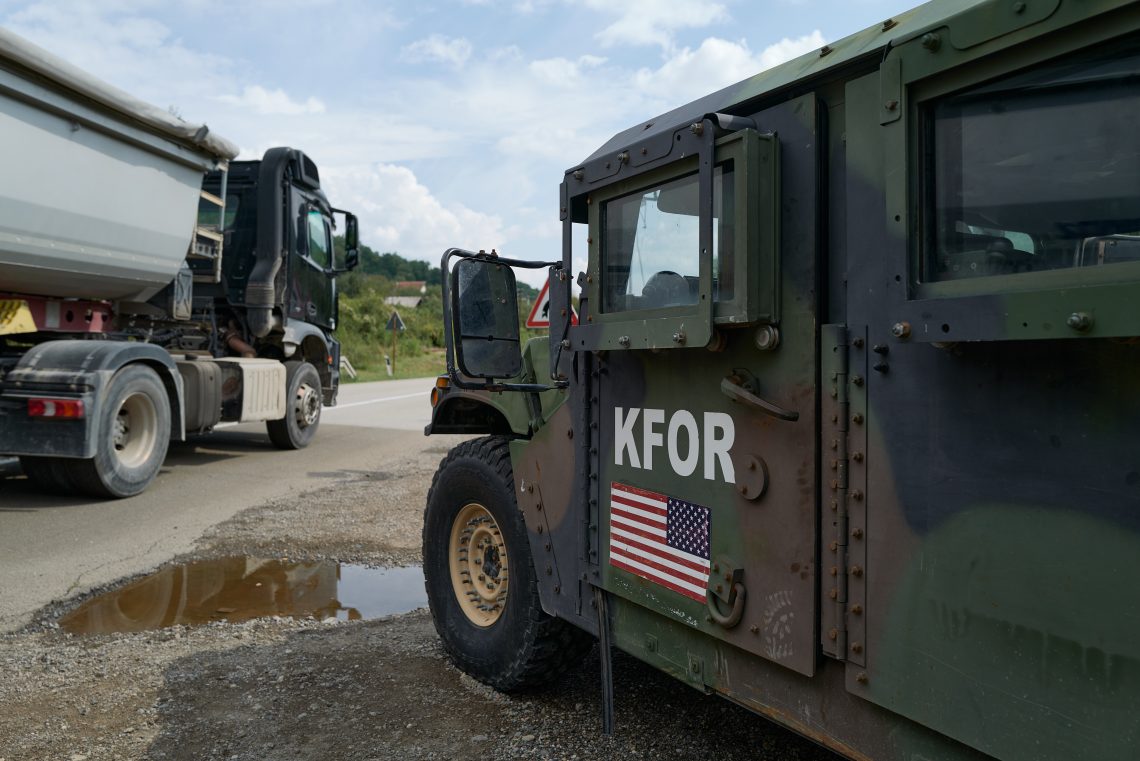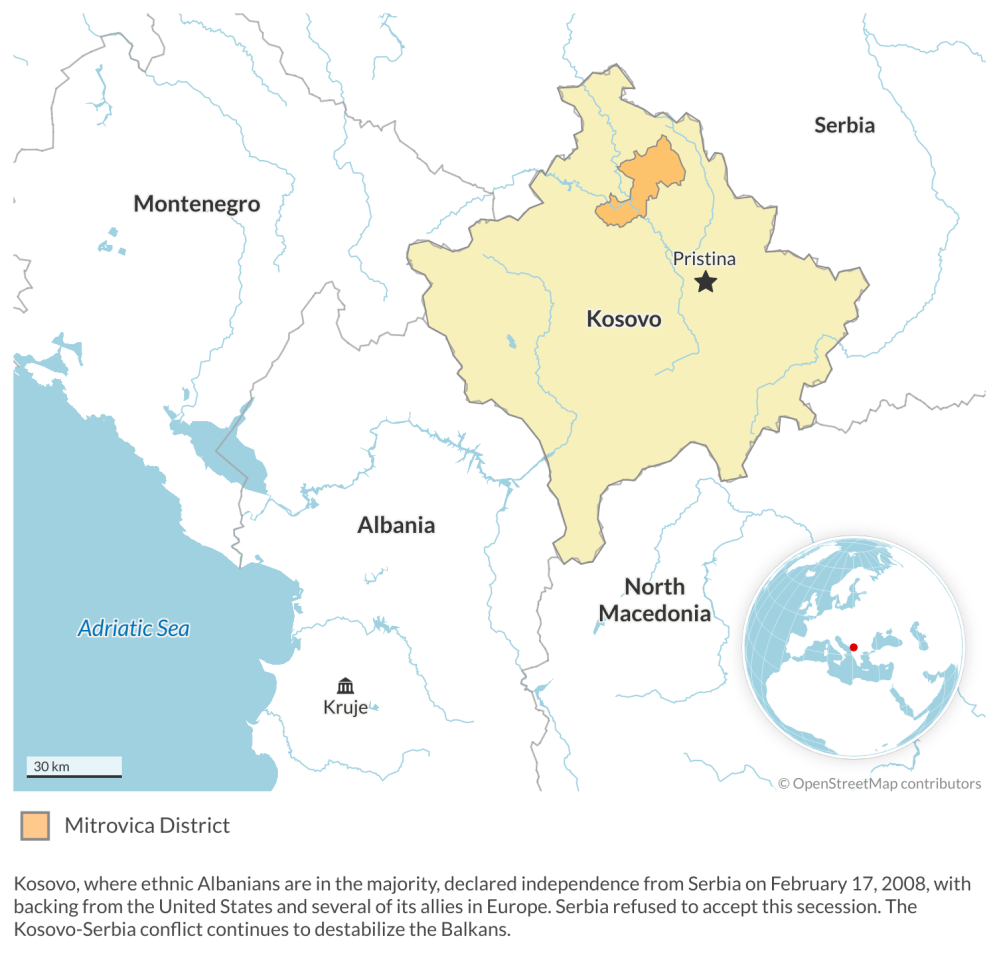Kosovo: Scenarios for an unfinished secession
The Albanian majority struggles to administer the entire territory of Kosovo. The northern province inhabited largely by Kosovo Serbs is a ticking time bomb.

In a nutshell
- Not fully recognized under international law, Kosovo is a “de facto state”
- Serbia consistently refuses to accept Kosovo Albanians’ 2008 secession
- The fate of Kosovo hinges on Serbia and the outcome of war in Ukraine
Almost 15 years ago, Kosovo proclaimed its independence from Serbia. The territory’s history is complicated, and it has no ingrained democratic tradition or patterns of independent governance. While 115 out of the 193 United Nations member states – including all seven G7 countries – have recognized the Republic of Kosovo, its standing under international law is not fully clarified.
It is politically awkward that several European Union member states – Cyprus, Greece, Romania, Slovakia and Spain – do not acknowledge Kosovo as an independent country. Globally, eight G20 countries, including five significant BRICS nations (Brazil, Russia, India, China and South Africa) along with Argentina, Indonesia and Mexico, have not yet recognized Kosovo. Academic literature refers to such disputed territories as “de facto states.”
Denials of statehood recognition frequently arise when political boundaries do not align with ethnic demarcations, and prospective states act against separatist tendencies.
History and ethnic crux
The ethnic majority of Kosovo is Albanian, with Kosovo Serbs concentrated in the northern Mitrovica district. Other minorities include Turks, Bosnians, Roma and Balkan Egyptians. This mixture of peoples with a sizable Serbian minority and, on top of that, the distribution of ethnic Albanians across Albania, Kosovo, Montenegro and in Tetovo, North Macedonia, and Presovo, Serbia, render consensual policymaking in the area extremely difficult.
Facts & figures
Factbox: Kosovo’s eventful history
- Progon, the first Albanian ruler known by name, an archon (lord) of the Kruja Fortress, founded the first Albanian principality in the area in 1190. It functioned as an autonomous part of the Eastern Roman (Byzantine) Empire.
- Subsequently, however, it was never possible to incorporate the entire Albanian settlement area into one state. Various regional powers (Naples, Venice, the Ottoman Empire) annexed the region over the course of history and from 1918, Kosovo found itself as part of Yugoslavia.
- Only during the Italian occupation of Albania (1939-1943) were the borders drawn in such a way that Kosovo and the Albanian areas of Macedonia became part of the Albanian state. However, this demarcation was only recognized by the Axis powers and was dropped after World War II.
- After the collapse of the Socialist Federal Republic of Yugoslavia in 1992, Kosovo remained part of Serbia in the then Federal Republic of Yugoslavia, but lost much of its autonomy in 1998, when Serbian President Slobodan Milosevic abolished it. The so-called Kosovo War lasted from early 1998 until mid-1999.
Several years into the resistance led by the Kosovo Albanians’ rebel group (Kosovo Liberation Army), waves of refugees began to pour into the EU and Switzerland. While those on all sides committed war crimes, a vast majority of them have been attributed to all manner of Serbian formations. The war ended after NATO’s March 1999 air strikes on the Serb’s positions led to their withdrawal from Kosovo.
Facts & figures
In June 1999, the government of the Federal Republic of Yugoslavia agreed to place Kosovo under the control of a UN transitional government. On June 9, 1999, Resolution 1244 provided for a civilian and military presence with comprehensive political and military powers. NATO’s Operation “Joint Guardian” began soon after, initially deploying over 48,000 soldiers from 30 nations.
Uphill struggle to tame violence
This author took part in this operation in 2002 as the National Contingent Commander of the Swiss troops. The civilian component was simultaneously handled by the United Nations Interim Administration Mission in Kosovo (UNMIK), which was initially responsible for nearly all civilian tasks, from human rights protection to reconstruction, court operations, policing and administration.
In addition to existing feelings of revenge toward Kosovars of Serbian origin, disputes among the clans often gave rise to violence.
Nevertheless, after the ceasefire and the installation of the UN mission and the NATO-led Kosovo Force (KFOR), there were massive expulsions of non-Albanians from the territory of Kosovo. Around 230,000 people were forced to flee, and about 40 Serbian Orthodox monasteries and churches were looted or destroyed.
Read more on Western Balkans
Bosnian Serbs stress-test the Dayton Agreement
Integrating a half-empty Balkans into the EU
China’s rising influence in the Balkans
Yet KFOR was able to use checkpoints and house searches to confiscate massive quantities of weapons and explosives that were still available in Kosovo; they came from the Yugoslavian army and even Wehrmacht stocks. The confiscations led to a rapid reduction in illegal armed violence.
The established clan structures in Kosovo were a unique feature. In addition to existing feelings of revenge toward Kosovars of Serbian origin, disputes among the clans often gave rise to violence. In addition, organized crime quickly took root, too, and began to exploit the power and legal vacuum. Arms, drug and human trafficking and large-scale smuggling had to be restrained. The various players on the ground – and, from 2008, also the European Union Rule of Law Mission in Kosovo (EULEX), a more technical mission that looks after the police, judiciary and administration in Kosovo – support many projects, but their effectiveness has been limited.
Facts & figures
The Republic of Kosovo’s mixed standing
- Even though the International Court of Justice has ruled that Kosovo’s secession does not violate international law, the republic’s status remains disputed.
- It is a member of the International Monetary Fund (IMF) and the World Bank Group. However, Kosovo has been denied UN membership because of Russia’s and China’s veto.
- Recognized by leading sports federations, such as the International Olympic Committee and soccer’s FIFA and UEFA organizations, Kosovo can participate as a nation in international sports tournaments and competitions.
Nearly a quarter century after Serbia’s sovereignty over Kosovo ended, the situation on the ground remains volatile. In addition to the expulsion of a significant portion of the Serbian minority from the republic’s territory, numerous violent developments have taken place. For example, in 2004, when around 50,000 Kosovars turned against ethnic Serbs, Roma and Ashkali (Balkan Egyptians), 19 people were killed, more than 1,000 injured and some 4,000 displaced. Many clashes have occurred between Kosovars and Serbs in the Mitrovica area.
Serbian pressure
To this day, the sovereignty of the state of Kosovo does not extend over its entire territory. The north, populated mainly by Serbs, refuses to be fully integrated into the republic. Serbian car license plates are still in use there, illustrating the extent to which the Kosovar administration has failed to extend its authority into the region.
The Kosovo Police can hardly work north of Mitrovica because Kosovo Serbs there have no tolerance for Kosovars of Albanian origin. The Serb minority’s persistent refusal to participate in elections creates an entirely distorted picture of the will of the people of Kosovo. Candidates of Albanian origin are sometimes elected and promoted to office with very few votes, which, in turn, leads to a lack of public support. In some cases, the elected officials are reduced to needing protection to reach their workplaces.
As recently as September 23, 2023, there was a Serbian army concentration along the Kosovan border, with heavy equipment deployed on a scale not seen since the end of the Kosovo War. At some point during the tense confrontation, 30 Serbian troops entered a Kosovar village. Several people were killed before things were brought back under control.
According to personal statements of a senior KFOR officer who recently returned from the mission, the mandate as to how its peacekeepers should behave in the north of Kosovo is generally vague. In addition, all combat units and heavy equipment have been withdrawn over the years, which calls into question their effectiveness in the event of a more serious crisis. The capabilities of the KFOR as a so-called third responder are essentially limited to “freedom of movement” and “crowd and riot control” operations. However, the number of its troops has recently been increased from 3,700 to 5,200.
One should not take from this that Serbia leans toward recognizing the Republic of Kosovo.
Small-bore mediation
Kosovo’s circumstances are complex and not comparable with those in Central Europe. Parallel structures, widespread organized crime, profound problems with ethnic minorities, massive foreign influence, no-go zones for state authorities and continued dependence on the international presence all paint a grim picture.
Nevertheless, Serbia and Kosovo agreed on a plan in February 2023 to normalize some of their relations, with measures like the mutual recognition of identity cards, diplomatic representations, educational certificates, national emblems and a few other practical matters. However, one should not take from this that Serbia leans toward recognizing the Republic of Kosovo. The plan was not negotiated between Belgrade and Pristina but imposed on the two sides by the EU and the United States.
In economic terms, the EU continues to support the development of infrastructure in Kosovo and its transition from brown coal-fired electricity generation to renewable energy. Investment in the republic depends primarily on foreign subsidies.
Scenarios
The likelihood of Serbia reintegrating Kosovo as its province without the deployment of military force is extremely low. However, the question is whether Serbia’s strategic goal is to integrate into the EU, as it claims – or, in fact, if it is based on the assumption that a resurgent power, Russia, will shape Serbia’s future as a brother nation. The outcome of the war in Ukraine and Russia’s post-war position in Europe will likely be decisive for the future of this part of the Western Balkans. The fate of Kosovo depends largely on Serbia’s behavior. This is particularly the case because neither the EU nor the U.S. is particularly happy with how the Kosovo secession has played out so far.
Serbia opts for EU membership
For Kosovo’s independence to win full international acceptance, the volatile post-war situation in Kosovo and relations with Belgrade would first need to improve significantly and stabilize. However, little in Serbia’s behavior suggests it wants this scenario. Formal recognition of Kosovo by Serbia, Brussels’s sine qua non condition for integrating Serbia into the EU, still does not seem to be in the cards.
Serbia bets on Russia
Serbia waits to see the outcome of the war in Ukraine and Russia’s post-war position in Europe. If Russia emerges strong, Belgrade could be tempted to intensify its pressure on Kosovo, massively hindering its progress as an independent country seeking full international recognition.
For industry-specific scenarios and bespoke geopolitical intelligence, contact us and we will provide you with more information about our advisory services.











